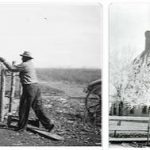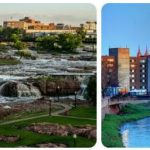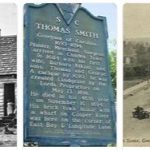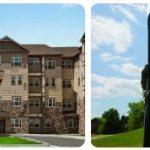South Dakota, Mt. Rushmore State is located in the Great Plains of North America. Surrounded by six states, Wyoming and Montana to the west, North Dakota to the north, Minnesota and Iowa to the east, and Nebraska to the south, the area just northeast of Belle Fourchet in Butte County, claims to have been the geographic center of the entire United States.
History of South Dakota
When French explorers, the LaVerendrye brothers, arrived in South Dakota in 1743, the area was inhabited by Sioux (Dakota)Indians. Sioux moved into the area in the second quarter of the 18th century and soon displaced the earlier inhabitants, Hidatsa, Mandan and Arikara.
The US acquired most of South Dakota from Francein 1803 with the Louisiana Purchase. Following the deal, President Thomas Jefferson commissioned the Discovery Corps and selected Lewis and Clark to lead the expedition. They spent the late summer and early fall in 1804 in the South Dakota region.
In 1817, a fur trading post was established in today’s Fort Pierre and was the start of American settlement in the area. An 1858 agreement with the Yankton Sioux ceded much of eastern South Dakota to the US.
The Dakota Territory, which included the present day North and South Dakotas and parts of Wyoming and Montana, was organized in March 1861. Following the completion of the railroad to Yankton in 1873 plus a gold discovery in the Black Hills in 1874, the Settlement of people from the eastern US and northern Europe was fast.
Statehood of South Dakota
On November 2, 1889, statehood was established for both North and South Dakota. The exact order of admission of the two states remains unknown. Due to the letter position, North Dakota is considered to be the 39th state and South Dakota, the 40th.
The Indian Wars were frequent with the last major conflict occurring between the Sioux Indians and the US in the Wounded Knee Massacre. At least 146 Sioux were killed, including women and children and 31 American soldiers.
Economy of South Dakota
During the 1930s, the lack of rainfall, high temperatures and over-cultivation of farming land resulted in the Dust Bowl. Large sandstorms blew away the fertile topsoil, resulting in ruined crops.
These unfavorable economic conditions drove many people away from the state, resulting in a decline in population.
The 1940s saw economic stability return to South Dakota as demand for agricultural products grew and construction began on six large dams, four of them partially located in South Dakota.
South Dakota, although still dependent on its agricultural products, has diversified its economy. The financial services sector expanded as several large companies moved their credit card activities to the state. Ethanol production has had a significant impact on the economy as South Dakota is one of the top producers in the US.
South Dakota Tourism
Tourism is now the second largest contributor to the economy. Mount Rushmore National Memorial attracts over three million visitors each year when they come to look at the head sculptures of four former US presidents: George Washington, Thomas Jefferson, Theodore Roosevelt and Abraham Lincoln.
From its climate with four distinct seasons, to its vast range of scenery, South Dakota is “a land of endless variety.”
South Dakota timeline
1700s
- (1743) French explorers, the LaVerendrye brothers, claimed the province of France
- (1750) Sioux tribes moved to Dakota
- (1794) Jean-Baptiste Trudeau founded a trading company
1800s
- (1803) US acquired South Dakota from France in the Louisiana Purchase
- (1804) Lewis and Clark Expedition arrived in South Dakota
- (1817) Joseph Laframboise started a trading post at Fort Pierre, the oldest continuous white settlement in South Dakota
- (1823) Arikara Indians attacked fur trading party, 12 merchants killed and 11 wounded
- (1861) Dakota Territory was established; William Jane appointed governor
- (1863) First farm filed in Dakota Territory
- (1868) Treaty signed with Sioux continued by the Great Sioux Reservation which included the Black Hills
- (1874) Gold was found in the Black Hills; the gold rush has begun
- (1876) Homestake gold mine opened; the Sioux war occurred and General Custer and the 7th Cavalry defeated
- (1888) Major blizzard strikes, 35 people die
- (1889) South Dakota admitted to the Union as 40th state
- (1890) Wounded Knee Massacre occurred – 7th Cavalry killed more than 250 Lakota men, women and children; Sitting Bull is killed at Little Eagle; Indian wars are over
1900s
- (1927) Gutzon Borglam began work on the Mount Rushmore National Monument
- (1930s) Severe drought and dust caused agricultural problems
- (1939) Badlands designated National Monument by President Franklin D. Roosevelt
- (1941) Mount Rushmore National Monument completed
- (1944) Congress passed the Choice-Sloan Plan for the construction of four dams: Fort Randall, Oahe, Gavin Point and Big Bend
- (1948) Korkak Ziolkowski began work on Crazy Horse Mountain
- (1949) Blizzard hit South Dakota; railroad from Pierre to Rapid City blocked for serveral weeks; hay air cargo drop required
- (1952) Major flood caused damage all over the state, flooded much of Pierre
- (1960) Ben Reifel was chosen as the first Indian to serve in Congress
- (1962) Oahe Dam completed, began production under electricity
- (1963) Cold War escalated and ICBM missiles were placed around the state
- (1972) Rapid City area flood kills over 200
- (1973) Riots by Indian Movement supporters occurred at Injured Knee II and Custer Court.
- (1980) Chicago, Milwaukee, St. The Paul & Pacific Railroad closed several thousand miles of track, which affected more than half of the state’s total railroad run; US Congress approves payment of $122 million to Sioux Indians to compensate for lands seized in 1877
- (1987) Lottery started; launch the destroyed block into the historic center of the city of Deadwood
- (1988) Severe drought conditions caused crop failure and lack of supply for cattle; Lightning sparks big wildfire in Black Hills destroying 16,000 acres
- (1990s) ICBM missiles removed
2000s
- (2007) The National Science Foundation selected Homestake, a former gold mine near Lead, as the site for a multipurpose deep underground science and technology laboratory
- (2010) South Dakota named the seventh best best to do business in the US by CNBC
- (2011) South Dakota had the third lowest unemployment rate in the US.








